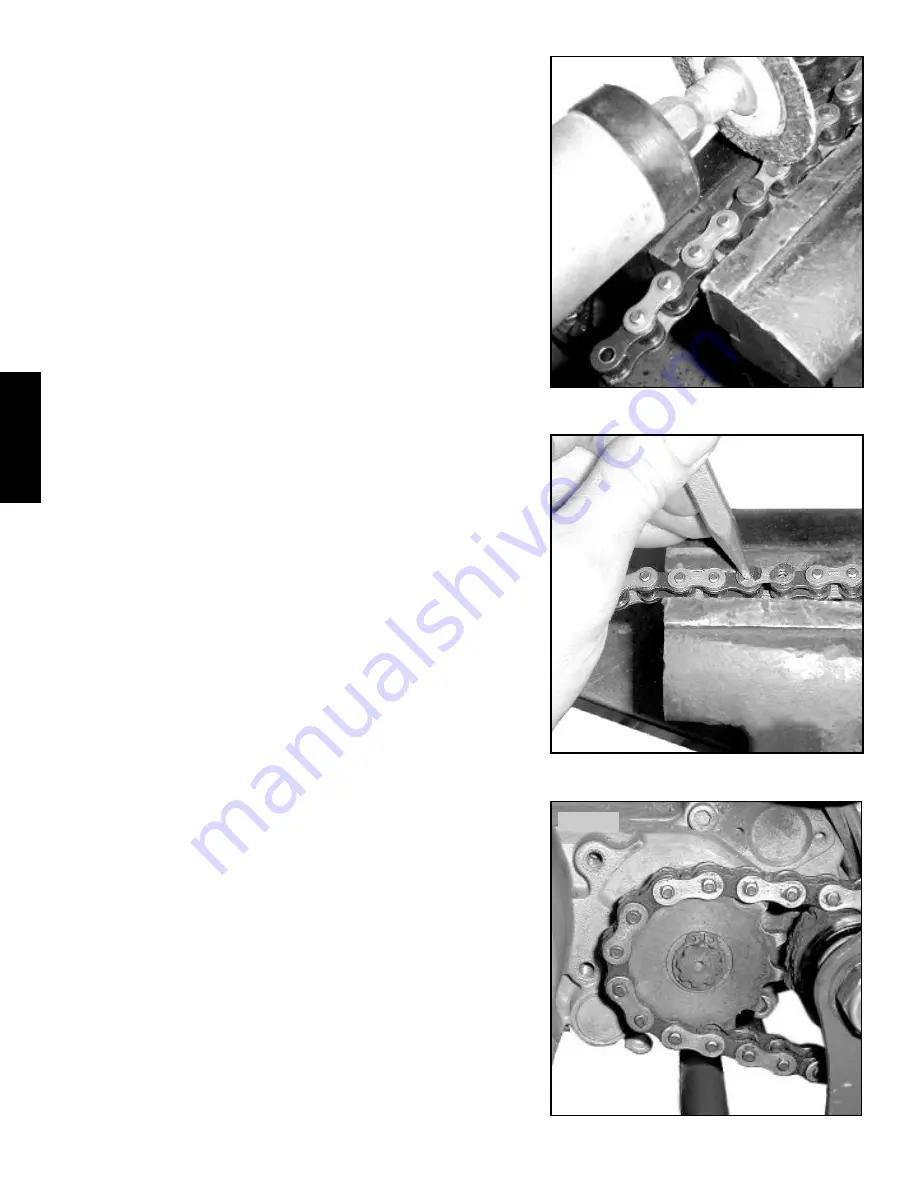
Page 40
I
I
I
Chain replacement -
Most replacement chains will be longer than needed and
will have to be trimmed to size. Remove the old chain by removing the master
link. The master link will have a U shaped spring clip holding the chain’s side
plate on. Pry the clip off with a screwdriver, remove sideplate, and remove
master link from chain. Spread the old chain out straight on the floor and lay
the new chain next to it to determine where to cut the new chain. Mark the
chain at the proper spot. Before cutting the chain, thread it onto the sprockets
and make sure the mark is at the correct spot. It is possible the existing chain
was shortened as it stretched, you don’t want to cut your new chain too short.
With the rear wheel adjusted almost all the way forward, your new chain
should be just long enough. Adjust your cut mark if needed. A special chain
breaker tool is available to cut the chain. If you do not have this tool, you will
have to drill or grind the ends of the rivets flush with the sideplate on the link
you wish to remove. See photo III-71. Then use a punch to drive the rivets
throught the sideplate and separate the link. See photo III-73.
Sprockets & gearing -
Check sprockets frequently for wear and damage. The
sprocket teeth will begin to “hook” when the sprocket is worn out. Do not let
sprocket wear become too bad or chain breakage may result. When changing
rear sprocket, use medium strength (blue) threadlocker on sprocket bolts and
torque to
XX ft/lbs
using a 10mm socket. To remove front sproket, remove
chain and use a pair of snap ring pliers to remove snap ring securing sprocket.
Note that the boss on the front sprocket should face inward, towards the motor.
Make sure the snap ring is fully seated in it’s groove when installing front
sprocket. See photo III-74.
Gearing -
The front and rear sprockets can be changed to alter the final gear
ratio of the motorcycle. Using more teeth on the front sprocket raises gearing,
while adding teeth to the rear sprocket lowers gearing. The calculate the actual
gear ratio, divide the number of teeth on the rear sprocket by the teeth on the
front sprocket. For example, with a 12 tooth front and and 42 tooth rear: 42/12
= 3.5 If you add a tooth to the front sprocket: 42/13 = 3.23 If you add a tooth
to the rear sprocket: 43/13 = 3.31 Adding teeth to the front sprocket makes a
roughly 3 times larger change in gearing than adding a tooth to the rear
sprocket. Note that a higher number is a “low” gear ratio, and a smaller num-
ber is a “higher” gear ratio. A higher ratio will increase the motorcycles top
speed, but reduces the responsiveness and acceleration. A lower gear ratio will
increase the responsiveness and acceleration but will lower the top speed. In
general you want to use the lowest gear ratio possible that will still allow the
speed needed for the fastest straightaway on the track. If too low a ratio is used,
the bike will start well (but may wheelie) and will run out of acceleration on
the fastest section of the track, allowing other bikes to pass. Too high of a ratio
will result in slower starts and more difficulty in deep sand or mud. A begin-
ning rider will generally benefit from a higher ratio until they can handle all
the acceleration of the lower ratios (try the 13 or 14 tooth front with the stan-
dard 42 rear).
Chain rollers, chain guide and wear pads -
The chain roller and wear pads
on the swing arm and chain guide are important for the proper life and opera-
tion of the chain and sprockets. Check the chain roller periodically to make
sure that it rotates freely. Replace if badly worn or frozen. Inspect the wear
pads on swingarm to make sure they are not worn through. Replace as needed
to prevent damage to chain or swingarm. Check wear pad in chain guide and
replace as needed.
Front sprocket & snap ring. (boss faces inward)
III
III
.74
.74
Grind or drill rivet heads flush.
Use a punch to remove sideplate.
III
III
.72
.72
III
III
.73
.73







































